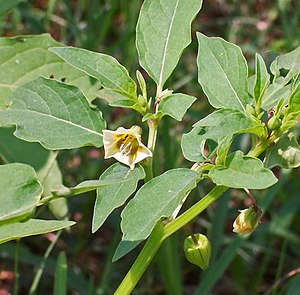Physalis angulata
| Physalis angulata | ||||||||||||
|---|---|---|---|---|---|---|---|---|---|---|---|---|

Physalis angulata |
||||||||||||
| Systematics | ||||||||||||
|
||||||||||||
| Scientific name | ||||||||||||
| Physalis angulata | ||||||||||||
| L. |
Physalis angulata is a plant type from the genus of jujubes ( Physalis ) in the family of the nightshade family (Solanaceae). It is the most common and widespread type of bladder cherries.
description
Physalis angulata is a creeping or upright herbaceous plant with a height of up to 1 m. The stem axis is angular and hairless except for fine, close-fitting trichomes on the young shoots. The up to 10 cm long leaves are egg-shaped or elliptical, pointed or tapering at the tip, the base is tapering and often sloping. The margins are whole, wavy, serrated or incised irregularly. The leaf stalks have about 1/3 to 1/2 the length of the leaf blade.
The flowers are on 5 to 12 mm long pedicels, which are finely covered with upwardly directed trichomes . At the time of flowering, the calyx is 3 to 5 mm long, 2 to 4 mm in diameter and hairless except for the edges and tips of the broadly pointed calyx tips. The crown is 4 to 10 mm long and soon bends backwards. The stamens are occasionally of unequal length, the stamens are slender, the 2 to 2.5 mm long anthers are bluish, sometimes merging into yellowish, with age they dry up or curve.
The fruits are 10 to 12 mm large, spherical berries that stand on 10 to 25 mm long stems, the calyx enlarges to 20 to 30 mm, is ten-edged or round and completely encloses the fruit.
The number of chromosomes is 2n = 48.
Occurrence and locations
The species is the most common and most widespread species within the genus of the bladder cherries ( Physalis ). The original range extends from Manitoba ( Canada ) to southern Argentina , but the species is now also widespread in the ancient world.
Plants can adapt to a wide variety of ecological conditions, but they do best in ruderal areas and other disturbed locations.
etymology
The type epitheton angulata refers to the conspicuous edges of the calyx on the ripe fruit.
literature
- WG D'Arcy: Family 170: Solanaceae . In: Robert E. Woodson, Jr., Robert W. Schery (Eds.): Flora of Panama, Part IX. In: Annals of the Missouri Botanical Garden. Vol. 60, No. 3, 1973. pp. 573-780, p. 662 online.
Individual evidence
- ↑ Physalis angulata at Tropicos.org. In: IPCN Chromosome Reports . Missouri Botanical Garden, St. Louis
